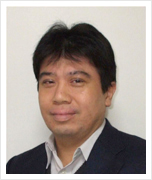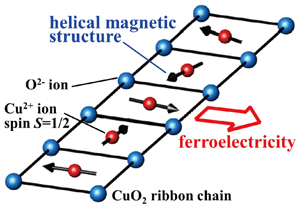Yasui, Yukio Associate Professor
 |
To the group homepage
http://www.isc.meiji.ac.jp/~yyasui/yasuilab.html
|
Academic Degree
PhD (Science), Nagoya University, Japan 1999
|
Membership in Academic Societies
The Physical Society of Japan
Japanese Neutron Scattering Association
American Physical Society
|
|
Research Interests
 |
|
Fig.1. Ferroelectricity is induced by a helical magnetic structure for CuO2 ribbon chains.(multiferroic behavior)
|
- (i)
- Condensed matter physics: magnetic, transport, heat, and dielectric properties of strongly correlated electronic systems, including superconductors, quantum spin magnets, frustrated systems, and multiferroic systems.
- (ii)
- Neutron scattering and X-ray diffraction: determination of magnetic structure and crystal structure of new transition metal oxides.
The discovery of new physical phenomena and new materials is on the frontier of condensed matter physics, which provides an important basis for current electronic and information technology research. The search for new materials with interesting physical properties is one of the most exciting and important projects. I am exploring the physical properties of strongly correlated electron systems, including transition metal oxides and rare earth ones. My research interest lies in the wide variety of physical phenomena in strongly correlated electron systems: new quantum phenomena, Mott metal-insulator transition, superconductors, magnetic frustration, quantum spin magnets, non-trivial magnetic structure, and multiferroic behavior (magnetic and ferroelectric transitions coexist: see Fig.1). Yasui group experimentally investigates these fields by means of the following methods. (i) Synthesize the polycrystalline and single crystal samples of transition metal and rare earth oxides (ceramic). (ii) Measure the magnetic, transport, heat, and dielectric properties in wide-temperature and magnetic-field regions. (iii) Identify the magnetic structure by neutron diffraction, directly observe the microscopic dynamics by inelastic neutron scattering, and analyze the crystal structure by synchrotron radiation X-ray diffraction.
Selected Publications
- Y. Yasui, M. Sato, and I. Terasaki, “Multiferroic behavior in the quasi one-dimensional frustrated spin-1/2 system PbCuSO4(OH)2 with CuO2 ribbon chains”, J. Phys. Soc. Jpn. 80 No. 3, 033707 (1-4), (2011).
- Y. Yasui, K. Sato, Y. Kobayashi, and M. Sato, “Studies of Multiferroic System LiCu2O2: I. Sample Characterization and Relationship between Magnetic Properties and Multiferroic Nature”, J. Phys. Soc. Jpn. 78, No. 8, 084720 (1-5), (2009).
- Y. Yasui, Y. Naito, K. Sato, T. Moyoshi, M. Sato and K. Kakurai, “Relationship between Magnetic Structure and Ferroelectricity of LiVCuO4”, J. Phys. Soc. Jpn. 77, No. 2, 023712 (1-4), (2008).
- Y. Yasui, Y. Kobayashi, M. Soda, T. Moyoshi, M. Sato, N. Igawa and K. Kakurai, “Successive Magnetic Transition of the Kagomé Staircase Compound Co3V2O8 Studied in Various Magnetic Fields”, J. Phys. Soc. Jpn. 76, No. 3, 034706 (1-8), (2007).
- Y. Yasui, T. Kageyama, T. Moyoshi, M. Soda, M. Sato and K. Kakurai, “Studies of the Anomalous Hall Effect and Magnetic Structure of Nd2Mo2O7 –Test of the Chirality Mechanism–”, J. Phys. Soc. Jpn. 75, No. 8, 084711 (1-11), (2006).
- Y. Yasui, M. Kanada, M. Ito, H. Harashina, M. Sato, H. Okumura, K. Kakurai and H. Kadowaki, “Static Correlation and Dynamical Properties of Tb3+-moments in Tb2Ti2O7 –Neutron Scattering Study–”, J. Phys. Soc. Jpn. 71, No.2 599-606, (2002).
- Y. Yasui, H. Sasaki, M. Sato, M. Ohashi, Y. Sekine, C. Murayama and N. Mori, “Studies of Pressure-Induced Mott Metal-Insulator Transition of BaCoS2”, J. Phys. Soc. Jpn. 68, No.4, 1313-1320, (1999).











